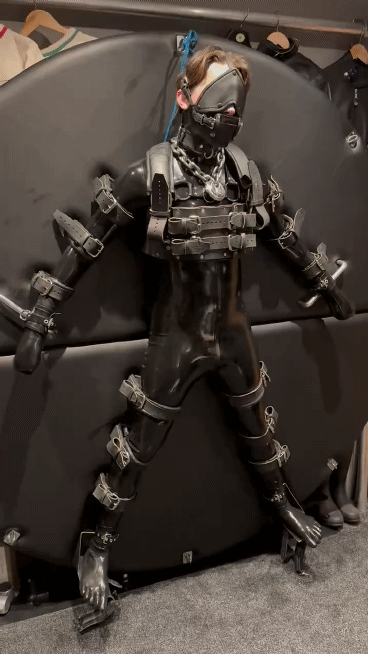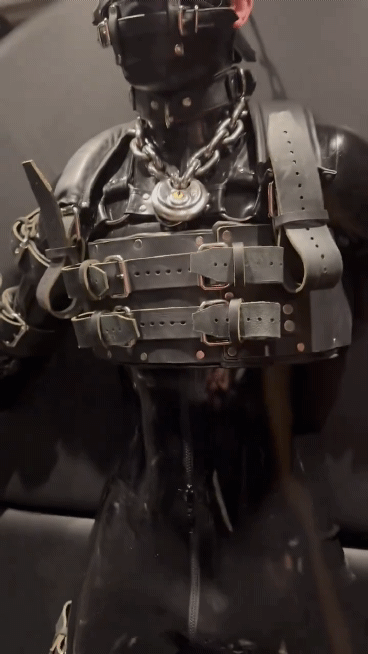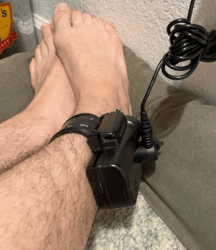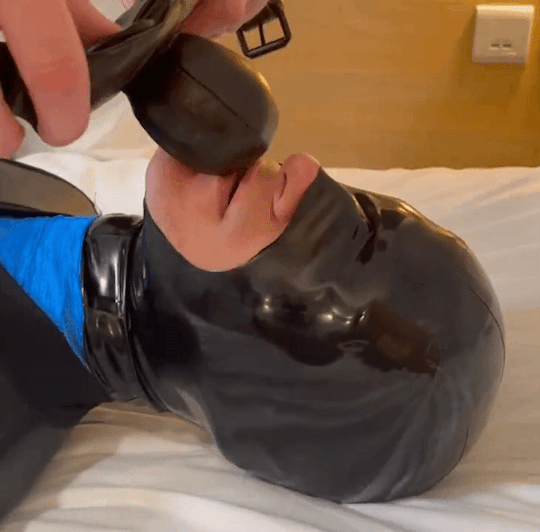Don't wanna be here? Send us removal request.
Text

One of the Orleans Parish Sheriff's Office escapees after capture!
A spit hood, leg irons and cuffed behind the back gives some indicator of the authorities displeasure!


I happen to own one of those jumpsuits! Probably won't wear that at Mardis Gras!!!
74 notes
·
View notes
Text

Some heavy duty BOA handcuff / leg irons combo recently gifted to FCJ. Awesome restraints!
94 notes
·
View notes
Text
102 notes
·
View notes
Text
18 year old convict having his ball and chain checked by a guard circa 1908
Innate #1010 seems to have a fresh headshave and some serious dirt from hard labor!
79 notes
·
View notes
Text
ABOUT THE SECURITY OF HANDCUFFS

It is of course of great importance that steel handcuffs and other restraints such as leg-irons are safe. Not only safe for the wearer in the sense that they may not pinch dangerously and thus constrict the blood circulation; hence the double-lock system. But also safe from the perspective of the police or the prison authorities: the absolute certainty that a handcuffed detainee or inmate can never escape from the steel bracelets that are closed around his wrists even when he is left completely unattended for a few moments.


So, first of all, they must also be strong and unbreakable. To what extent they are also regularly inspected after purchase is an interesting question, about which I have not been able to find anything. It is probably useful for each team of guards to have its entire stock of handcuffs, leg-irons and other shackles and chains checked periodically to see if they are still functioning properly.

But in any case, there are standard regulations regarding the quality of new handcuffs. On the internet I came across this short report from the US Department of Justice from 1982, containing the 'Standard for Metallic Handcuffs' of the National Institute of Justice'.
You can find the complete document on PdF here: www.govinfo.gov/app/details/GOVPUB-J28-PURL-gpo77836
It contains a good schematic illustrations of the standard handcuffs used in the States, the model with a very short chain in between.

I'll cite the most important points of its content:
In Table 1 are listed 16 possible defects in workmanship. Paragraph 4.4 states: "The handcuffs shall be free from them". I'll cite some:
Any part missing, broken, malformed. loose. or not in proper alignment.
Rivet or pin insecure or not secured neatly.
Key cannot unlock handcuff or requires undue force to do so. n. Handcuff cannot be double-locked.
Handcuff ratchet does not lock automatically with the pawl.
Any malfunctioning in the opening or closing of the handcuffs: e.g., ratchet binds or does not rotate freely.
How important are those defects? Let's look for that at paragraph 4.1
" Acceptance Criteria. The handcuffs meet the requirement of this standard if four or more of the five handcuff specimens pass all of the tests." Well, I must confess: a rather disturbingly flexible criterion. It does not enhance my trust in the U.S. Prison authorities very much!
It means that it apparently isn't a problem for them when 1 out of 5 handcuffs doesn't meet the conditions! Let's say: doesn't lock very well or at all, can't be opened after being locked, is lacking a crucial part . It means, if there is for 1 out of 5 prisoners hope for escape from cuffs, the U.S. National Institute of Justice just shrugs its shoulders.

Who of the five in the pic above is the lucky one? And who of the five in that below? In that prison van there will surely be an opportunity for him to free himself from his shackles unnoticed and then give the guard a good beating as soon as the door is unlocked after arrival..... And what will the authorities then say after that? It's all in the game?

Buit let's continue. Interesting is paragraph 4.6, about Dimensions: "Each handcuff of each pair shall have a minimum opening of 50 mm for insertion of the wrist. The inside perimeter of the handcuff shall be a minimum of 200 mm when the ratchet is engaged at the first notch entering the locking mechanism. The inside perimeter of the handcuff shall be a maximum of 165 mm when the ratchet is engaged at the last notch entering the locking mechanism. The maximum overall length of the pair of handcuffs shall be 240 mm".

I've taken a look at my brandnew Smith & Wesson belly-chain-with-side-handcuffs. In that case the opening measures exactly 50 mm. The ratchet has 19 teeth. Indeed the perimeter ranches from 165 to 200 mm. In my case, the last notch gives a nice tight - but right - fit.

Then there is paragraph 4.5 about Weight. It saus: "The weight of the pair of handcuffs shall not exceed 425 g". A minimum is not given. The pair of handcuffs I use for my leather waistbelt (see pic below) weigh some 300 g. So they are allowed, and i can't complain. And, yes, i tried: but none of my cuffs are among those 20% of failures...

Then, last but not least, there is paragraph 4.7: Mechanical Strength.
"Each pair of handcuffs shall withstand a tensile force of 2200 N (495 lbf) for a period not less than 30 s when tested in accordance with paragraphs 5.6.1 and 5.6.2. The handcuffs shall not open under load, shall show no sign of permanent distortion or fracture and shall function in a normal manner* following these tests."
Well, 2200 Newtons needed as a minimum to break the chain between the handcuffs sounds quite safe. The greatest pulling force ever measured in men was 400 Newtons - not even a fifth. And he certainly couldn't hold it for half a minute. What's your maximum?
So, alas, boy: no chance to escape from those very, very nice safe handcuffs that are already waiting for you! So now place your left wrist neatly in this cuff so we can lock it properly. After that your other wrist will follow in the next, and you will be properly secured. Don't worry!

79 notes
·
View notes
Text


Take it easy gimp. The night is just beginning and you know I won't let you go anywhere, right? 😈🔥
1K notes
·
View notes
Text
From now on, others will make the decisions for him... Good for him.
3K notes
·
View notes
Text
Chased down chav lad - P.1
My latest run in with the law... chased down and shackled up, turns out I'm shit at hiding 🤣
Trackies n Airmax TNs muddy from trying to get away, being perped walked all the way thru woods in chains and cuffs, to a van waiting for me, its a long way
87 notes
·
View notes
Text
143 notes
·
View notes
Text

They just arrived at the prison and have had their socks and shoes confiscated, as well as wearing belly chains and handcuffs. They are happy, because they will have the life they always dreamed of, and soon they will have their beautiful uniforms, and they will lie in their cells for a good part of their lives.
It seems indeed so, that they are enjoying their situation. And of course it someway must be rather exciting for a boy to be captured and shackled for the first time. But will they remain so cheerful when they are taken away in a special prison van to a high-security juvenile detention center? A severe penitentiary like Pendleton Maximum Security Juvenile Prison in Indiana?
These - again: four - juvenile prisoners in this clip, still wearing their own clothes, but now with their hands locked in a stacked position into a black box, and with their feet provided with leg-irons, seem quite intimidated by their new surroundings upon arrival.
109 notes
·
View notes
Text

THE BELLY CHAIN WITH HANDCUFFS AT THE SIDES
In a former entry of this tumblr-blog, a few months ago, I already paid attention to the probably most relaxing form of full restraints, used for transport of prisoners, or during a court-hearing: the belly-chain with the (for security reasons always inevitable) two handcuffs now attached separately to the sides, instead of being fixed as a standard pair to the front of such a chain (sometimes with a black box added) or - a very popular solution - with the connecting short chain inserted through the frontal ring D-ring of a thick leather waist-belt. Of course leg-irons are added to make the whole into a set of full restraints.

As I wrote then commenting on a situation as the one in this pic here: "The way those guys wear their handcuffs is the most comfortable of all alternatives: not a pair linked together on the back, or a pair attached to the belly chain at the front, which would leave little room for manoeuvre. Because there are handcuffs attached separately to the side, the prisoners can let their arms hang down next to their upper bodies in a very natural way".

Since a few days I am the happy owner of such a belly-chain with side-cuffs, manufactured by good old Smith & Wesson. I got the stuff from a German mail order-company, specialized in cuffs and shackles of all kind from all over the world. Here's a pic from their site.

To give the most important measurements: The chain from the large O-ring at one end to the place where the short chain with the first handcuff is secured to a small O-ring is about 30 cm long. That short chain is just 7 cm long. The length between the O-rings with the handcuffs is about 35 cm. The remaining chain on the other side until the final small O-ring is about 65 cm long, so all together about 130 cm: so that should be sufficient for more corpulent inmates too.

In my case it turned out that, to prevent the belly-chain from sagging under the weight of the heavy padlock (a Masterlock), I needed to use the most tight position possible. So I had to put the heavy padlock through the first O-ring of the whole range, just some 10 cm beyond the second handcuff. It means that in my case a fairly large part of the belly-chain hangs down folded in half against one buttock.

This belly-chain with side-cuffs is rather comfortable to wear, as it indeed gives much more room for manoeuvre than the most frequent alternatives. To be sure: when the belly-chain is applied in a tight way and both handcuffs are locked securely, escaping from your restraints is just as impossible as with the black-box variant. But you can do much more independently, and that for sure is not only an advantage for the restrained inmate but also - supposing that he is not a violent, but an easy one - in a way for the guards, as he needs less support with some standard physical actions.

Of course I tried out what was possible and impossible, while being restrained this way. In the first place, you can cross your arms in a way. A lot of prisoners do automatically. This pic shows the left cuffed inmate nearly doing the same as his free lawyer next to him.

So, if you have access to the key, you can - what's impossible with a pair of handcuffs attached to the frontal D-ring of a waistbelt, let alone with a black box - free yourself, at least, if you place the handcuffs in such a way that the keyholes are on the inside, so both keyholes pointing to each other. If crossing hands is easy, this too.



Then the short chains connecting the cuffs to the belly-chain turns out to be just long enough to enable you to put the key in the handcuff around the other wrist with one hand and turn it. I didn't dare to see if that would work with the keyholes on the outside. Maybe just about. No doubt a careful guard for that reason would always choose the latter option (and of course make sure the prisoner can't get to any key). Anyhow: much more freedom of movement than in case of the waist-belt with D-ring-plus-handcuffs.
Compare!: the lucky three inmates above can swing their hands rather freely in one or the other direction: crossing hands or keeping them far apart at will, the chain connecting their handcuffs to the belly-chain offering a turning circle with a radius of 10 centimeters.

The inmate who has to wear that leather waist-belt finds his wrists almost immovably fixed to the D-ring of that belt, the supershort chain between both cuffs leaving only very little room for manoeuvre: he can do no more than turn his hands a bit inside the cuffs. He can't lift them, he can't move them apart, he can just fold them to pray.

What’s further possible? The handcuffs allow you with some pains to eat with help of your hands. Drinking is nearly as difficult as with the alternatives - waistbelt and black-box – as you can’t reach high enough with your hands to tip a cup without spilling.

Completely problem-free are all those actions for which you barely have to lift your hands: like unfastening the bottom snap of your striped prison jumpsuit to pee. Also peeing itself is easy. As is signing documents like your confession of guilt during your trial in court - with a black-box that is really much more difficult. Taking an oath seems a bit more difficult to me, because there is no actual raising of your hand; it remains a modest gesture. Compare this pic if two inmates with sidecuffs with that clip of one wearing a black-box

To be sure: forget every attempt to serious resistance. Although you can move your hands rather free around and therefore will not suffer from cramps quickly, you are really no match for any guard. He just grabs you by the shoulder and in case of obstinate behavior pushes or pulls you in the desired direction, without you being able to do anything about it. Thus no guard has to fear real violence by an inmate who is restrained this way.

Prisoners can therefore also do little physical harm to each other; if they all walk around in the common area shackled like this, the guards have much less to worry about; the risk of bloody fights is - as long as no knives have been smuggled in - minimal.

In fact, this kind of belly-chain with side-cuffs could be worn by inmates during most hours of the days without being a huge obstacle to many of their average actions. They can play cards, they can write letters (I myself wrote a large part of this text on my PC while being in handcuffs), and when it’s time for dinner, they can carry a tray and serve a plate. With a little bit of leaning forward you can also get the food into your mouth without making too much of a mess.

And a very big advantage: you can also do all kinds of physical work in it. Not everything of course, but those where you don't have to lift your hands too much, ad/or can keep them a piece apart. Use a shovel or broom, push a wheelbarrow par example. Some other jobs can probably be done very well with two people, with a specific division of labor. In other words: the necessary community work outside the prison walls can be done by inmates who are fitted out with this bellychain with side-cuffs, of course in combination with leg-irons to minimize the risk of escape. That is safe for everybody!

Because: a lot of the community work you see in the next pictures, could be done while staying restrained outside in the way described.

Dragging bags of waste or other contents...Yes, you do have to wear them differently in that case... Like the guys on our very first pic...

Collecting waste - you then can do it together: one inmate holds the plastic bag open, the other scoops up the dirt and throws it in.

Caring for plants, if you place them at the appropriate height.

This would be no problem while sidecuffed - instead of those bins with the laundry you can also push a wheelbarrow with manure.

A shovel, a broom, pruning shears, a rake: using them is no problem.

Most of this work can be done with a belly-chain-plus-sidecuffs too...
And what will they do in the fields that can be done in restraints?

So, let's go for it. Three inmates i n prison stripes ready for transport to work. Will their leg-irons and belly-chain plus side-handcuffs stay on, once arrived at the site where they have to do community-work?

138 notes
·
View notes
Text










Post 1400
Skylar Nemetz, Washington inmate 389979, born 1994, incarceration intake April 2016 at age -- , scheduled discharge date not published
Manslaughter
In March 2016, former soldier Skylar Nemetz was given the maximum sentence of 13 1/2 years in the shooting death of his wife, Danielle.
Nemetz knew he'd have to serve some time in prison. His attorney admitted that his client was responsible in some fashion. He'd hoped for manslaughter second degree, but the jury bumped it up one notch to first degree.
In court Judge Jack Nevin looked at the defendant and said, "Mr. Nemetz, you are an expert. You are an expert." That was the prevailing theme throughout the trial -- the fact that Nemetz had been around guns all his life and was a trained soldier. He's never denied that he's the one responsible for his wife's death. But he claimed it was a terrible accident.
Prosecutors claimed it was an intentional shooting by a jealous husband just back from military training and asked for a verdict of first degree murder. In the end the jury could not unanimously agree on the more serious charges and convicted Nemetz of first degree manslaughter saying he was criminally reckless in how he handled the weapon.
5m
25 notes
·
View notes
Text

i thought you all should see that my Officer put an ankle monitor on me as i await my trial and sentencing—though i have a strong feeling he will keep in on me for the rest of my life. at 5 AM, i woke up to it vibrating and beeping telling me to charge it as directed. now, everywhere i go, my Officer can see and requires me to request permission or otherwise be punished.
THIS POST WAS NOT PRE-APPROVED BY SIR.
117 notes
·
View notes






